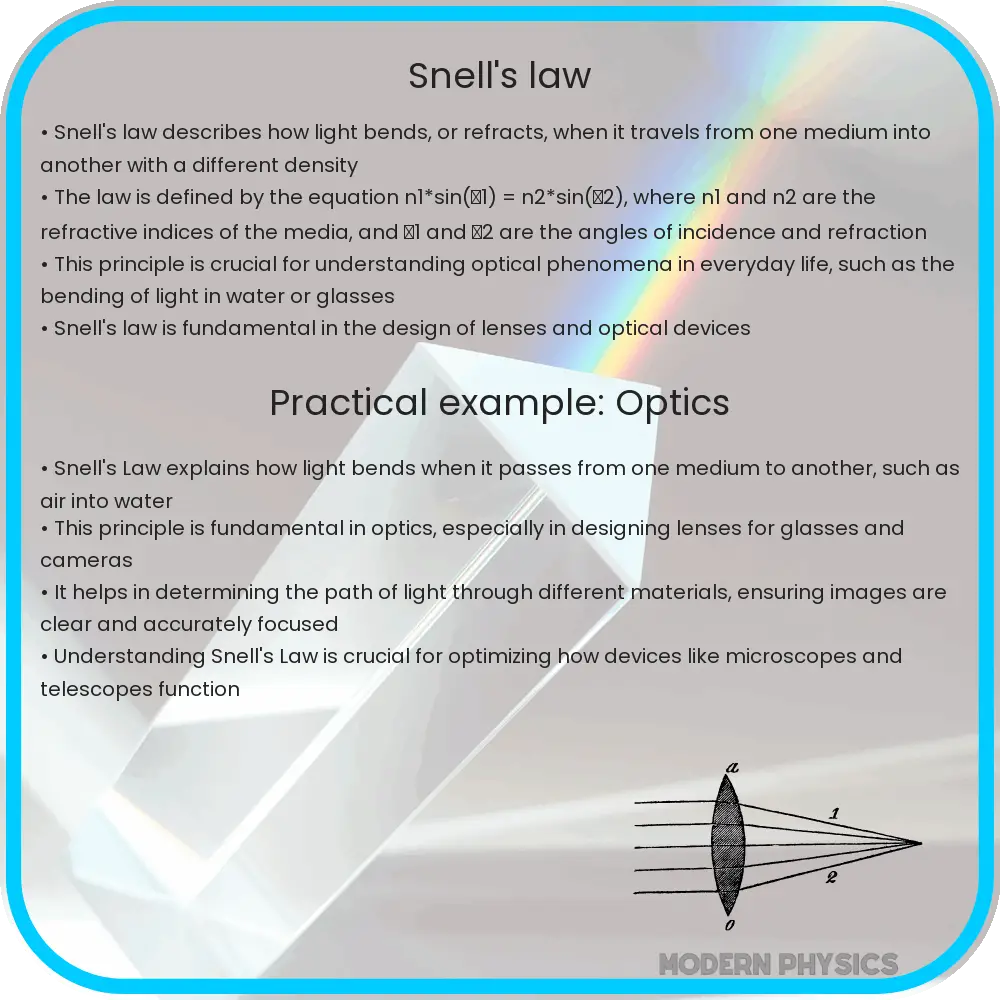Explore Snell’s Law in wave optics and physics, its impact on technology and science, from fiber optics to medical imaging and vision correction.

Understanding Snell’s Law in Wave Optics and Physics
Snell’s Law, a fundamental principle in wave optics and physics, describes the behavior of light as it travels through different media. This law is crucial in understanding the phenomenon of light refraction, which occurs when light waves pass from one transparent medium into another, changing direction due to a change in their speed.
The Basics of Snell’s Law
Snell’s Law is mathematically expressed as:
\[ n_1 \sin(\theta_1) = n_2 \sin(\theta_2) \]
where \( n_1 \) and \( n_2 \) are the refractive indices of the first and second medium, respectively, and \( \theta_1 \) and \( \theta_2 \) are the angles of incidence and refraction, respectively. The refractive index of a medium is a measure of how much the speed of light is reduced inside the medium compared to its speed in a vacuum.
Applications of Snell’s Law
Snell’s Law is not just a theoretical concept; it has practical applications in various fields. In optics, it’s used to design lenses and optical instruments like microscopes and telescopes. In telecommunications, it aids in the design of fiber optic cables for efficient light transmission. Understanding Snell’s Law is also crucial in geophysics for seismic wave studies.
Refraction and Light Behavior
Refraction is a result of the change in speed of light as it moves from one medium to another. When light enters a denser medium, it slows down and bends towards the normal line; conversely, it speeds up and bends away from the normal when moving into a less dense medium. This bending is why objects appear distorted or shifted when viewed through water or glass.
Wave Optics: Beyond Simple Refraction
Wave optics, or physical optics, deals with the complex phenomena of light as a wave. It explains not only refraction but also other phenomena like diffraction and interference. Snell’s Law plays a vital role in wave optics, providing a foundation for understanding these complex behaviors of light waves.
In the next part, we’ll delve deeper into the implications of Snell’s Law, exploring its impact on modern technology and scientific research.
Exploring the Implications of Snell’s Law in Modern Technology and Science
Snell’s Law is more than a basic principle of physics; it’s a cornerstone in many modern technological advancements. Its applications extend to various fields, from engineering to medical science.
Snell’s Law in Fiber Optics
In the realm of telecommunications, Snell’s Law is essential for the design and functioning of fiber optic cables. These cables rely on total internal reflection, a phenomenon explained by Snell’s Law, to transmit light signals over long distances with minimal loss. This principle is pivotal in providing high-speed internet and telecommunications around the globe.
Medical Imaging and Snell’s Law
In medical imaging technologies, such as ultrasound and endoscopy, Snell’s Law helps in understanding how light or sound waves will travel through various tissues or mediums. This understanding is crucial for producing clear and accurate images used in diagnostics and treatments.
Enhancing Vision through Optics
Optometry and ophthalmology heavily rely on Snell’s Law for designing corrective lenses. By calculating how light bends when passing through different lens materials, opticians can create glasses and contact lenses that correct vision impairments like myopia or hyperopia.
Snell’s Law in Environmental and Earth Sciences
In environmental science, Snell’s Law assists in understanding atmospheric phenomena, like the bending of light rays during sunrise and sunset. In earth sciences, it aids in the analysis of seismic waves, which helps in studying the Earth’s interior and predicting earthquakes.
Conclusion
Snell’s Law, a fundamental concept in wave optics, extends its influence far beyond the basic understanding of light refraction. It underpins many modern technologies and scientific advancements, from the internet and medical imaging to environmental analysis and vision correction. Its universal applicability in different fields demonstrates the profound impact that a single scientific principle can have across multiple disciplines. Understanding Snell’s Law not only illuminates the path light takes through various media but also sheds light on the boundless possibilities of scientific exploration and technological innovation.
